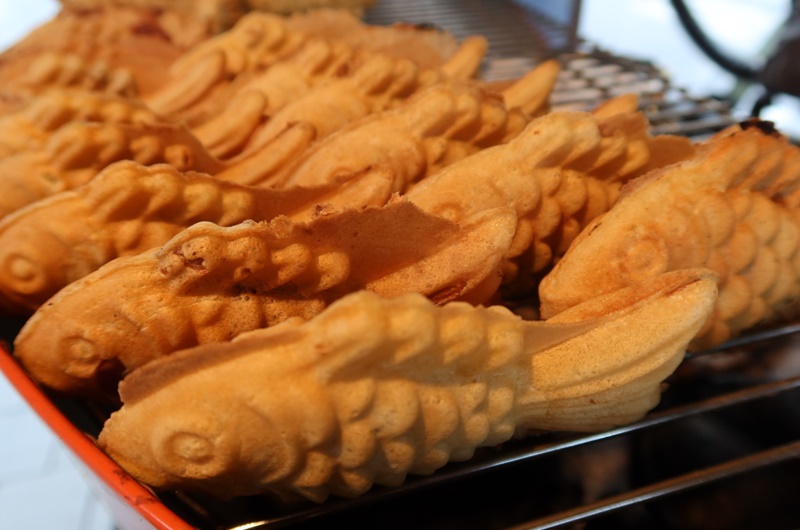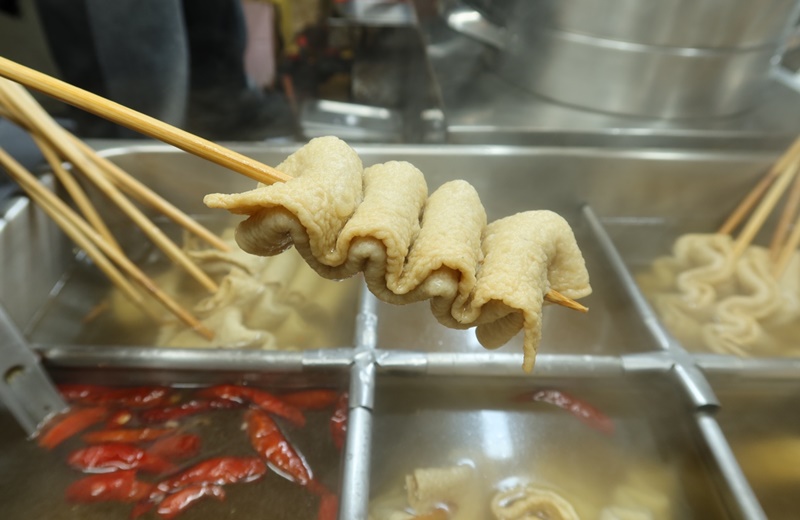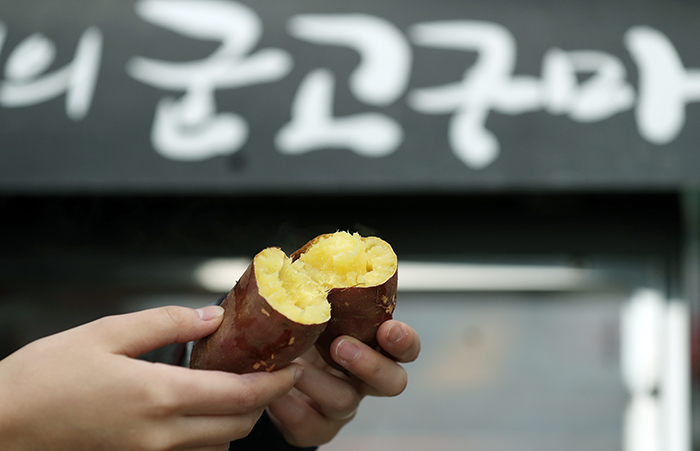When the weather gets cold in winter, certain street snacks come to mind in Korea. Bungeoppang (fish-shaped bun filled with red bean paste), eomuk (fishcake), gyeranppang (egg bread), hotteok (sweet filled pancake) and gungoguma (roasted sweet potato) are among the nation's most popular winter snacks amid freezing weather.
Five Korea.net staff writers share their go-to winter street snacks in Korea: Elias Molina from Costa Rica, Kim Hyelin from Korea, Sarah Oqelee from Egypt, Anais Faure from Guatemala and Kim Yeojin from Korea.

Bungeoppang is a fish-shaped bun made with flour batter and red bean paste. (Kim Yeojin)

Elias' pick: bungeoppang
It was midwinter with heavy snow when I first came to Korea. Being a university student back then, I had my first bungeoppang on a street near my school. This fish-shaped snack made with flour batter and nutty red bean paste creates a culinary harmony with fluffy bread. Nowadays, the variety of bungeoppang features an array of fillings including custard cream (my favorite), sweet potato mousse and pizza toppings. I find it impressive because of its fish shape, which is hardly seen among other countries' desserts. When my family and friends come to Korea in winter, I always have them try the treat. The price in downtown Seoul is KRW 1,000 for two or three pieces but varies by region.

Chewy eomuk (fishcake) and its warm soup quickly warm up people in freezing weather. (Kim Yeojin)

My favorite street snack is undoubtedly eomuk, or fishcake. While it does not stimulate my sense of smell like bungeoppang with its sweet scent or that of hearing like hotteok with its sizzling sound when cooked, eomuk has a secret weapon: soup. Made by frying ground fish meat and skin after being mixed with flour, this treat has dozens of recipes but the ones most popular on the street during winter are usually accompanied by soup. When feeling bone-chilling cold on my way home from work, I look for a pojangmacha (street kiosk) that sells this food. Taking one fishcake skewer, dipping it in soy sauce and taking a bite, I taste the great harmony created by the chewiness of the fishcake and saltiness of the soy sauce. Drinking a sip of the soup, my cold body warms with a deep taste boiled for a long time and I cry "Ha!" naturally. Nowadays, vegan fishcake has appeared as an option. The price is KRW 500-KRW 1,000 per stick in downtown Seoul but varies by region.
![undefined Gyeranppang </span>is a soft and fluffy loaf of bread containing a whole egg. (iclickart) *[Unauthorized reproduction and redistribution of the above photo is strictly prohibited under copyright laws and regulations]](/upload/content/editImage/20211206110113247_CAAM0YJT.jpg)
Gyeranppang is a soft and fluffy loaf of bread containing a whole egg. (iclickart) *[Unauthorized reproduction and redistribution of the above photo is strictly prohibited under copyright laws and regulations.]

This was the first street snack I had in Korea. In my first winter here in 2012, the gyeranppang I tried for the first time on the street tasted soft, warming my body and mind amid extremely cold weather. The main ingredients are eggs and flour. Even to me, a newly arrived expat with little experience in Korean food, the taste of gyeranppang was not strong at all. Any non-Koreans will enjoy the snack if they like eggs. The price is KRW 1,500-KRW 2,000 per piece in downtown Seoul but varies by region.
![undefined Hotteok </span>is a sweet pancake with glutinous rice dough filled with brown sugar and pressed flat on an oiled iron plate. (iclickart) *[Unauthorized reproduction and redistribution of the above photo is strictly prohibited under copyright laws and regulations]](/upload/content/editImage/20211206110425910_D0LRD9T8.jpg)
Hotteok is a sweet pancake with glutinous rice dough filled with brown sugar and pressed flat on an oiled iron plate. (iclickart) *[Unauthorized reproduction and redistribution of the above photo is strictly prohibited under copyright laws and regulations.]

A snack popular with Koreans, this is made by filling glutinous rice dough with brown sugar and pressing it flat on an oiled iron plate. Cooked with a lot of oil, the snack has a crispy texture. One bite makes sweet melted sugar flow out into my mouth for a pleasant taste. The types also vary from a seed version with nuts including sunflower seeds and peanuts to those with green tea powder or japchae (stir-fried glass noodles and vegetables) as ingredients. When eating honey-filled hotteok, it reminds me of eating sweet desserts in my native Guatemala, whose desserts are mostly filled with honey and taste similar to hotteok. The price is KRW 1,000-KRW 2,000 per piece in downtown Seoul but varies by region.

Gungoguma (roasted sweet potato) is eaten hot while blowing on it, making it a perfect winter snack. (Korea.net)

The sweet smell of gungoguma (roasted sweet potato) signals winter's arrival. This roasted sweet potato is eaten hot while blowing on it, making a perfect winter snack. When roasted over a fire with its skin unpeeled, it has a chewy texture on the outside and creamy and deep sweetness on the inside. This delicacy is even better when eaten with fermented food with a refreshing flavor such as dongchimi (water radish), baechu (cabbage) kimchi and nabak (thinly sliced radish) kimchi. A bite of roasted gungoguma warms my heart. A drum canister specially made to cook it until a few years ago was often seen at street kiosks serving this food, though they have greatly declined in number. Though convenience or department stores sell it, I sometimes miss the roasted version hot and straight from the canister. The price is KRW 2,000-KRW 3,000 per piece in downtown Seoul but varies by region.
lvzhen@korea.kr
